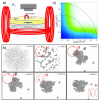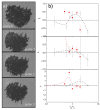Field-Pulse-Induced Annealing of 2D Colloidal Polycrystals
- PMID: 36770358
- PMCID: PMC9921439
- DOI: 10.3390/nano13030397
Field-Pulse-Induced Annealing of 2D Colloidal Polycrystals
Abstract
Two-dimensional colloidal crystals are of considerable fundamental and practical importance. However, their quality is often low due to the widespread presence of domain walls and defects. In this work, we explored the annealing process undergone by monolayers of superparamagnetic colloids adsorbed onto fluid interfaces in the presence of magnetic field pulses. These systems present the extraordinary peculiarity that both the extent and the character of interparticle interactions can be adjusted at will by simply varying the strength and orientation of the applied field so that the application of field pulses results in a sudden input of energy. Specifically, we have studied the effect of polycrystal size, pulse duration, slope and frequency on the efficiency of the annealing process and found that (i) this strategy is only effective when the polycrystal consists of less than approximately 10 domains; (ii) that the pulse duration should be of the order of magnitude of the time required for the outer particles to travel one diameter during the heating step; (iii) that the quality of larger polycrystals can be slightly improved by applying tilted pulses. The experimental results were corroborated by Brownian dynamics simulations.
Keywords: 2D confined systems; colloidal annealing; dynamic self-assembly; fluid interface; superparamagnetic particles.
Conflict of interest statement
The authors declare no conflict of interest.
Figures





References
-
- van der Meer B., Filion L., Dijkstra M. Fabricating large two-dimensional single colloidal crystals by doping with active particles. Soft Matter. 2016;12:3406. - PubMed
-
- Zahn K., Lenke R., Maret G. Two-Stage Melting of Paramagnetic Colloidal Crystals in Two Dimensions. Phys. Rev. Lett. 1999;82:2721. doi: 10.1103/PhysRevLett.82.2721. - DOI
-
- Yan J., Bae S.C., Granick S. Rotating crystals of magnetic Janus colloids. Soft. Matter. 2015;11:147. - PubMed
-
- Glotzer S.C., Solomon M.J. Anisotropy of building blocks and their assembly into complex structures. Nat. Mater. 2007;6:557. - PubMed
Grants and funding
LinkOut - more resources
Full Text Sources

